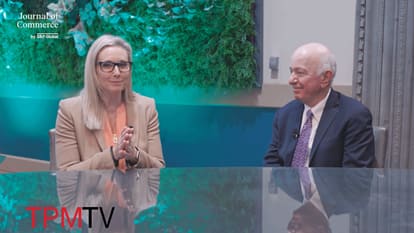- Program
- What's New
- Speakers
- Who's Attending
- TPM Community
- Partners

TPM Partnership
Partnership places your company in a position of authority and enables you to build and strengthen your relationships, visibility and reputation with major shippers
LEARN MORE - Media

TPM TV
Episodes of exclusive TPM content featuring interviews of key stakeholders and attendees.
WATCH NOW - About

About TPM
The must-attend conference for the trans-Pacific and global container shipping and logistics community
LEARN ABOUT TPM - Get Updates
- FAQ's
Sessions With Greg Knowler
Monday, 4 March
-
02:35pm - 03:20pm (PST) / 04/mar/2024 10:35 pm - 04/mar/2024 11:20 pm
Ocean Carrier Service Reliability: The Sobering News from Sea-Intelligence
It’s an unpleasant but unavoidable reality for shippers coming out of the COVID era. While freight rates and port congestion have normalized, schedule reliability is still far below where it was pre-COVID. The main reason is that, in a largely futile effort to put a floor under a falling market, carriers have been aggressively managing capacity through blank sailings, slow steaming, and unscheduled port calls. While that has kept vessel load factors higher and perhaps avoided an unmitigated rate war, it has meant greater unpredictability for shippers’ supply chains, longer transit times, and, in some cases, lost revenue and higher costs. The big question is, how long will it last? In this solo session, Alan Murphy, CEO of Sea-Intelligence, the world’s foremost authority on schedule reliability, will offer his views of the future of service reliability, while answering these questions and more:
• Is this the new, post-COVID normal that shippers will have to suffer through for the foreseeable future?
• Will certain carriers choose to take a different tack and deliver schedule reliability even if it means committing to more deployed capacity?
- Speakers:
- Alan Murphy
- Greg Knowler
Tuesday, 5 March
-
02:15pm - 03:00pm (PST) / 05/mar/2024 10:15 pm - 05/mar/2024 11:00 pm
Trade Lane Focus: Surplus Capacity and Weak Demand Will Extend Asia-Europe's “Transition to Normalization”
Many in container shipping regarded 2023 as a “transition” year between the pandemic disruptions and a normalizing market, but judging from the weak demand and an unprecedented surge in capacity on the Asia-Europe trade, that transition will take longer. One of the greatest challenges for carriers over the next two years will be finding a way to somehow balance supply and demand. Estimates from various analysts put demand in 2024 at 3% while available capacity will grow by 7%. Maritime consultant Drewry estimates that 2.5 million TEU of capacity will be delivered globally by the end of 2023 and 3 million TEU in 2024. But at least 65% of the ordered tonnage consists of vessels with a capacity greater than 15,000 TEU, and the only place for most of that will be on the Asia-Europe trade. With little expectation of a great resurgence in demand among European consumers in 2024, the sheer capacity being deployed in 12-ship service strings will be difficult to fill. That spells disruption for cargo owners with carriers having little option but to continue aggressively blanking sailings, despite the strategy having little effect on plunging rate levels through the nonexistent 2023 peak season. With such a capacity overhang, carriers are simply unable to withdraw enough tonnage to make a material difference on rates. Where material differences are being made, however, is on service levels. Blank sailings, service cuts, and port emissions are preventing carriers from returning schedule reliability on Asia-North Europe to acceptable levels. Despite the almost complete absence of port and terminal congestion, vessels in the last quarter of 2023 were still struggling to reach an average on-time performance of 70%. Another costly issue looming over European importers and exporters is the European Union emissions trading system (ETS) that takes effect on Jan. 1, 2024. Starting in the first quarter, carriers will levy quarterly emissions surcharges on every container handled in the region. The actual surcharge per container will only become apparent early in 2024 when the trading in emissions allowances begins, but Asia-Europe shippers already are making it clear they want to negotiate the ETS surcharges within rate contracts.
Related content:
Spot rate gains puts pressure on shippers delaying Asia-Europe contracts: Xeneta Shippers to bring European ETS surcharge into carrier contract talks- Speakers:
- Michael Amri
- Antonios Rigalos
- Peter Sand
- Greg Knowler
-
04:20pm - 05:00pm (PST) / 06/mar/2024 12:20 am - 06/mar/2024 01:00 am
Trade Lane Focus: The Trans-Atlantic — Restoring Balance to a Loss-Making Lane
The withdrawal of capacity on the trans-Atlantic going into the fourth quarter did not match the sharp drop in demand from North American importers that has led to a complete collapse of the spot market. Average spot rates by the end of October were 40% lower compared to the same point in 2019, but a far more relevant comparison is that during the trade lane’s peak third quarter shipping season, average spot market prices declined 35% and long-term rates fell almost 60%. Despite rates stuck on the ocean bed — and pledges by liner CEOs that they will slash capacity on what has become a corridor stained with red ink — the trans-Atlantic Ocean carriers appear resigned to allowing rates to fall where they may in the hopes that demand from North America will finally begin to pick up. Hope is not a strategy, however, and by the end of September, the demand indicators were all heading south. Data from PIERS shows that US import volumes from North Europe have fallen every month since an 8.4% year-over-year increase in January and were down 26% in September. While comparisons with 2022 might not be particularly relevant, the US import volume in September of 151,900 TEUs was still almost 20% below that of the same month in 2018 and 2019. If the weak demand continues into 2024, cargo owners on the westbound trans-Atlantic should prepare for a significant round of blank sailings in the first quarter, mainly because carriers serving the US import corridor will simply have no other options. This session, featuring an industry analyst, freight forwarder, and shipper representative, will take a deep dive look at the trans-Atlantic, and what lies ahead in 2024.
Related content:
No bottom in sight for free-falling trans-Atlantic rates

